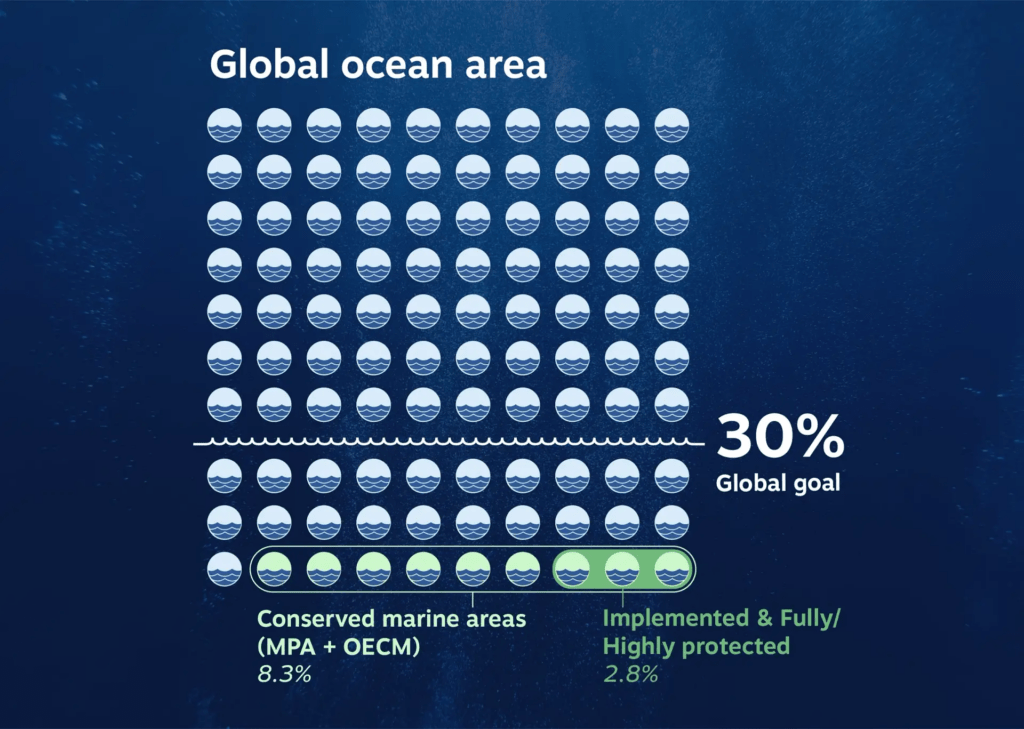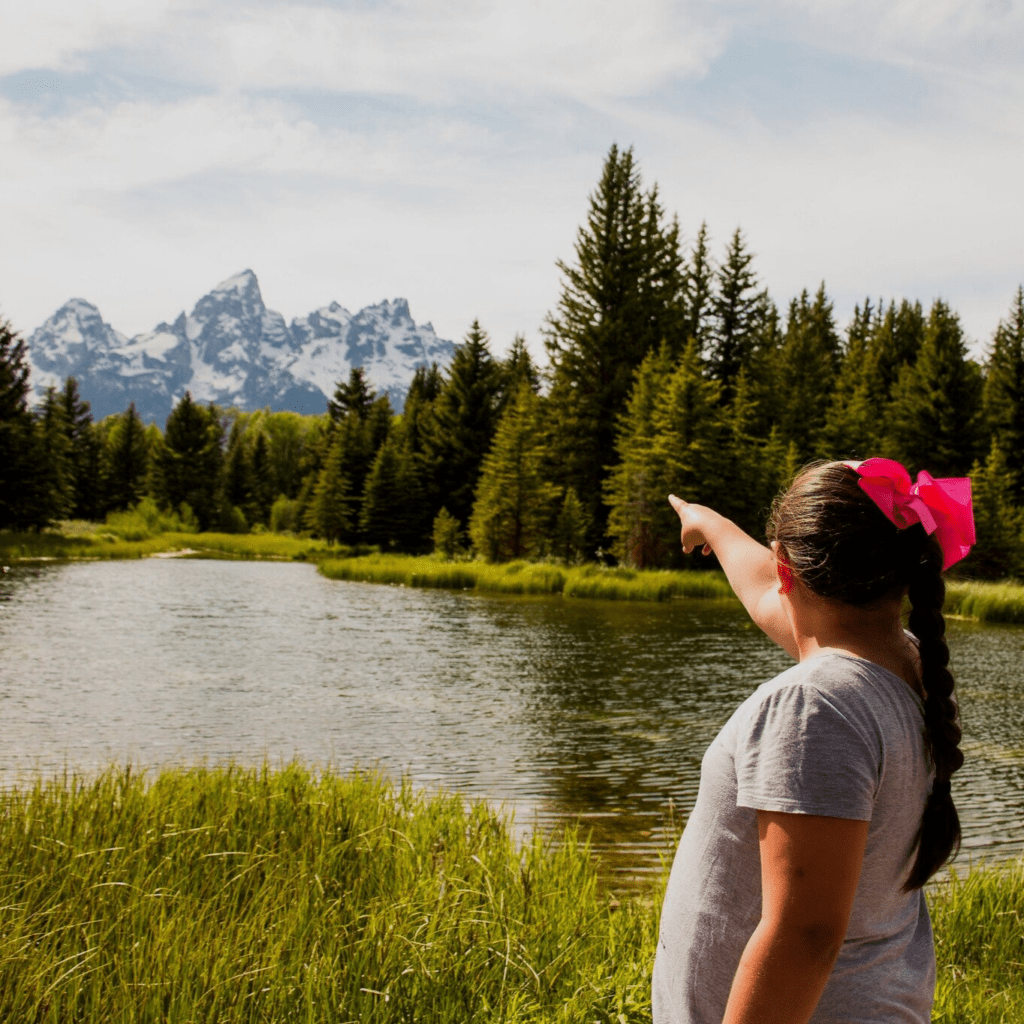The global ambition to protect 30% of the planet by 2030 (30×30 goal) is a cornerstone of efforts to address biodiversity loss and safeguard ecosystems. While progress has been made, with 17.6% of land and 8.4% of the ocean currently under protection, a significant gap remains to meet this target.
Current Challenges
The realization of the 30×30 goal, which aims to protect 30% of the planet’s land and marine areas by 2030, faces several significant obstacles that must be addressed to achieve this ambitious target.
One of the primary challenges is insufficient coverage. Despite efforts to expand protected areas, vast regions, particularly in marine ecosystems, remain unprotected. These unprotected areas are often critical habitats for numerous species and play essential roles in maintaining ecological balance. The lack of protection leaves these ecosystems vulnerable to overfishing, pollution, and other human activities that can lead to degradation and loss of biodiversity. Expanding the coverage of protected areas to include these vital regions is crucial for the success of the 30×30 goal.
Another major obstacle is data deficiencies. Effective conservation planning and management require comprehensive and accurate data on the effectiveness and governance of protected areas. However, there is often limited data available, which impedes strategic planning and decision-making. Without reliable information, it is challenging to assess the current state of protected areas, identify gaps, and implement necessary improvements. Enhancing data collection and monitoring efforts is essential to ensure that protected areas are managed effectively and contribute to biodiversity conservation.
Uneven protection is also a significant issue. Biodiversity hotspots, which are regions with exceptionally high levels of species richness and endemism, are often underrepresented in current protected zones. These areas are crucial for preserving global biodiversity, yet they frequently receive inadequate protection. Ensuring that biodiversity hotspots are prioritized and adequately protected is vital for achieving the 30×30 goal. This requires a more strategic approach to conservation planning that focuses on protecting the most biologically significant areas.
Inadequate funding poses another substantial challenge. Expanding and maintaining protected areas require significant financial resources, yet funding is often insufficient. Without adequate financial support, it is difficult to establish new protected areas, manage existing ones effectively, and implement necessary conservation measures. Securing sustainable funding sources and increasing investment in conservation efforts are critical to overcoming this obstacle. This may involve exploring innovative financing mechanisms, such as public-private partnerships, conservation trust funds, and international funding initiatives.
Addressing these obstacles requires a coordinated and collaborative effort from governments, conservation organizations, researchers, and the global community. Governments play a crucial role in enacting policies and regulations that support the expansion and effective management of protected areas. Conservation organizations can contribute by advocating for increased protection, conducting research, and implementing on-the-ground conservation projects. Researchers can provide valuable data and insights to inform conservation strategies, while the global community can support these efforts through awareness and advocacy.
In conclusion, while the 30×30 goal presents a promising vision for global conservation, several significant obstacles must be addressed to achieve it. Insufficient coverage, data deficiencies, uneven protection, and inadequate funding are key challenges that hinder progress. By addressing these issues through collaborative efforts and strategic planning, we can work towards realizing the 30×30 goal and ensuring a sustainable future for our planet’s biodiversity.

30% Global Ocean goals
The global ocean, which covers approximately 71% of the Earth’s surface, is a vital component of our planet’s ecological balance. It regulates climate, supports a vast array of biodiversity, and provides essential resources for human livelihoods. Recognizing the critical importance of marine ecosystems, the international community has set an ambitious target known as the 30×30 goal, which aims to protect 30% of the world’s oceans by 2030. This goal is part of a broader effort to conserve biodiversity and ensure the sustainability of natural resources for future generations.
As of now, significant progress has been made towards achieving this target. Approximately 8.3% of the global marine area has been designated as protected. These marine protected areas (MPAs) are established to conserve marine life and habitats, mitigate the impacts of human activities, and maintain the health of ocean ecosystems. However, it is important to note that not all protected areas offer the same level of protection. Within this 8.3%, only about 2.8% of the global ocean is considered to be fully or highly protected. Fully protected areas are those where all extractive activities, such as fishing and mining, are prohibited, while highly protected areas allow minimal human interference.
The distinction between different levels of protection is crucial for understanding the effectiveness of conservation efforts. Fully and highly protected areas are more effective at preserving biodiversity and ecosystem functions because they limit human activities that can cause harm. These areas serve as refuges for marine species, allowing populations to recover and thrive. They also help maintain the integrity of marine habitats, which are essential for the health of the entire ocean ecosystem. For example, coral reefs, which are among the most biodiverse ecosystems on the planet, benefit greatly from high levels of protection. In fully protected areas, coral reefs are less likely to suffer from the damaging effects of overfishing, pollution, and climate change.
Achieving the 30×30 goal requires not only expanding the coverage of MPAs but also ensuring that these areas are effectively managed and enforced. This involves setting clear conservation objectives, implementing robust monitoring and enforcement mechanisms, and engaging local communities in the management process. Effective management is essential for translating the designation of protected areas into real conservation outcomes. Without proper management, protected areas may exist only on paper, failing to provide the intended benefits for marine life and ecosystems.
In addition to expanding and managing MPAs, addressing the root causes of marine degradation is essential for the success of the 30×30 goal. This includes tackling issues such as climate change, pollution, and unsustainable fishing practices. Climate change poses a significant threat to marine ecosystems, causing ocean warming, acidification, and sea-level rise. Reducing greenhouse gas emissions and implementing climate adaptation strategies are critical for protecting marine life. Similarly, efforts to reduce pollution, such as plastic waste and chemical runoff, are necessary to maintain the health of marine habitats. Sustainable fishing practices, including the reduction of bycatch and the establishment of no-take zones, are also vital for preserving fish populations and marine biodiversity.
The 30×30 goal represents a bold and necessary step towards safeguarding the health of our oceans. By protecting 30% of the global ocean, we can ensure the preservation of marine biodiversity, support the resilience of ocean ecosystems, and secure the benefits that healthy oceans provide to humanity. Achieving this goal will require a concerted effort from governments, conservation organizations, researchers, and the global community. Through collaborative action and a commitment to sustainable practices, we can create a future where the oceans continue to thrive and support life on Earth.
Recommendations for Action
To accelerate progress towards achieving the 30×30 goal, the report outlines several key strategies that need to be implemented urgently and effectively.
One of the primary strategies is to increase the pace of expanding protected areas. Urgent measures are required to designate new protected zones, particularly in regions that are currently underrepresented. This involves identifying critical habitats and ecosystems that need protection and swiftly implementing conservation measures to safeguard these areas. Expanding protected areas at a faster rate is essential to prevent further loss of biodiversity and to ensure that a significant portion of the planet’s land and marine environments are preserved for future generations.
Another crucial strategy is to enhance the quality of protected areas. It is not enough to simply increase the number of protected zones; the focus must also be on effective management and equitable governance. This means ensuring that protected areas are well-managed, with clear objectives, adequate resources, and robust monitoring systems in place. Equitable governance involves including local communities and stakeholders in decision-making processes, ensuring that their rights and needs are respected. By improving the quality of management and governance, protected areas can achieve better conservation outcomes and provide greater benefits to both biodiversity and people.
Addressing the root causes of biodiversity loss is also a key strategy. This involves tackling the underlying drivers of environmental degradation, such as climate change, habitat destruction, pollution, and unsustainable agricultural and fishing practices. Implementing policies and practices that reduce greenhouse gas emissions, promote sustainable land use, and protect natural habitats is essential for reversing the trends of biodiversity loss. By addressing these root causes, we can create a more sustainable and resilient environment that supports both human and ecological health.
Empowering Indigenous Peoples is another vital strategy outlined in the report. Indigenous communities have long been stewards of the land and possess valuable traditional knowledge about sustainable resource management. Supporting Indigenous-led conservation efforts and recognizing their rights to land and resources are crucial for achieving effective and equitable conservation outcomes. This includes providing financial and technical support to Indigenous communities, involving them in conservation planning and decision-making, and respecting their cultural practices and knowledge systems. Empowering Indigenous Peoples not only enhances conservation efforts but also promotes social justice and equity.
Finally, securing sufficient funding is essential for the success of these strategies. Ensuring that there is adequate international and domestic financing to support the expansion and management of protected areas is critical. This involves mobilizing resources from various sources, including governments, international organizations, private sector investments, and philanthropic contributions. Innovative financing mechanisms, such as conservation trust funds and payment for ecosystem services, can also play a role in securing sustainable funding. By ensuring that financial resources are available and effectively utilized, we can support the long-term sustainability of protected areas and conservation initiatives.
Accelerating progress towards the 30×30 goal requires a comprehensive and multi-faceted approach. Increasing the pace of expanding protected areas, enhancing the quality of management and governance, addressing the root causes of biodiversity loss, empowering Indigenous Peoples, and securing sufficient funding are all critical strategies that need to be implemented. By working together and taking decisive action, we can achieve the 30×30 goal and ensure a sustainable future for our planet’s biodiversity.
Alternative Solutions
Complementary approaches can significantly bolster efforts to achieve the 30×30 goal and ensure the long-term health of our oceans. One key strategy is strengthening marine protection. This involves not only expanding the number of marine protected areas (MPAs) but also enhancing the level of protection within these areas. By establishing more fully and highly protected zones, we can create safe havens for marine life, allowing ecosystems to recover and thrive without the pressures of human activities such as fishing and mining.
Leveraging technology for monitoring is another crucial approach. Advances in technology, such as satellite imagery, drones, and underwater sensors, provide powerful tools for monitoring marine environments. These technologies can help track changes in marine ecosystems, detect illegal activities, and assess the effectiveness of conservation measures. By utilizing these tools, we can gather accurate and timely data that informs better management and enforcement of MPAs.
Promoting sustainable consumption is essential for reducing the impact of human activities on marine ecosystems. This includes encouraging the consumption of sustainably sourced seafood, reducing plastic use, and supporting products that do not harm marine life. Public awareness campaigns and certification programs can play a significant role in educating consumers and promoting sustainable choices. By making informed decisions, consumers can help drive demand for sustainable products and practices.
Empowering local communities is vital for the success of marine conservation efforts. Local communities often have a deep connection to their marine environments and possess valuable traditional knowledge about sustainable resource management. Involving these communities in conservation planning and decision-making ensures that their needs and perspectives are considered. Providing financial and technical support to community-led conservation initiatives can enhance their capacity to protect and manage marine resources effectively.
Developing ecotourism offers a sustainable economic alternative that can support marine conservation. Ecotourism focuses on responsible travel to natural areas, promoting conservation and benefiting local communities. By developing ecotourism initiatives, we can create economic incentives for preserving marine ecosystems. This not only generates income for local communities but also raises awareness about the importance of marine conservation among tourists.
Addressing climate change impacts is crucial for protecting marine ecosystems. Climate change poses significant threats to the oceans, including rising sea temperatures, ocean acidification, and sea-level rise. Mitigating these impacts requires global efforts to reduce greenhouse gas emissions and implement adaptation strategies. Protecting and restoring coastal habitats, such as mangroves and coral reefs, can enhance the resilience of marine ecosystems to climate change. Additionally, integrating climate considerations into marine conservation planning ensures that strategies are robust and adaptive to changing conditions.
In conclusion, achieving the 30×30 goal requires a multifaceted approach that includes strengthening marine protection, leveraging technology for monitoring, promoting sustainable consumption, empowering local communities, developing ecotourism, and addressing climate change impacts. By implementing these complementary strategies, we can enhance the effectiveness of marine conservation efforts and ensure the long-term health and sustainability of our oceans. Through collaborative action and a commitment to sustainable practices, we can create a future where marine ecosystems continue to thrive and support life on Earth.

In Short
Achieving the 30×30 goal, which aims to protect 30% of the planet’s land and marine areas by 2030, is undoubtedly ambitious but entirely feasible with concerted global action. This goal represents a significant step towards preserving biodiversity and ensuring the health of our planet for future generations. However, to make this vision a reality, several critical areas need to be addressed.
First and foremost, addressing gaps in coverage is essential. Currently, many critical ecosystems, particularly marine environments, remain unprotected. Expanding the network of protected areas to include these vital regions is crucial. This involves identifying and prioritizing areas that are rich in biodiversity and are under threat from human activities. By focusing on these high-priority areas, we can ensure that the most vulnerable and valuable ecosystems receive the protection they need.
Securing adequate funding is another key component. Conservation efforts require substantial financial resources to be effective. This includes funding for the establishment and management of protected areas, as well as for research, monitoring, and enforcement activities. Mobilizing resources from a variety of sources, including governments, international organizations, private sector investments, and philanthropic contributions, is essential. Innovative financing mechanisms, such as conservation trust funds and payment for ecosystem services, can also play a significant role in providing sustainable funding for conservation initiatives.
Improving governance and management of protected areas is equally important. Effective governance ensures that protected areas are managed in a way that maximizes their conservation benefits while also respecting the rights and needs of local communities. This involves developing clear management plans, establishing robust monitoring and enforcement mechanisms, and ensuring that local communities are actively involved in decision-making processes. By promoting transparent and inclusive governance, we can enhance the effectiveness of protected areas and build trust and support among stakeholders.
Supporting innovative and inclusive conservation solutions is another critical strategy. This includes embracing new technologies and approaches that can enhance conservation efforts, such as satellite monitoring, drone surveillance, and community-based conservation initiatives. It also involves recognizing and supporting the role of Indigenous Peoples and local communities in conservation. Indigenous communities have long been stewards of the land and possess valuable traditional knowledge about sustainable resource management. Empowering these communities and integrating their knowledge and practices into conservation strategies can lead to more effective and equitable outcomes.
In conclusion, while achieving the 30×30 goal is ambitious, it is entirely within reach with concerted global action. By addressing gaps in coverage, securing adequate funding, improving governance and management, and supporting innovative and inclusive conservation solutions, the international community can protect critical ecosystems and build a sustainable future. This collective effort will not only preserve biodiversity but also enhance the resilience of our planet’s ecosystems, ensuring that they continue to provide essential services and benefits for generations to come.
Related Content
- Progress Toward 30×30
- Global News Roundup: From Public Health to Climate Challenges
- Hong Kong Releases Sustainability, Climate Reporting Standards
- Climate Disruption Continues to Take a Toll on Global Health
- Azerbaijan Hosting COP29: A Climate Commitment or a Conflict of Interest?
- Revolutionizing Carbon Capture: UC Berkeley’s COF-999 Material Shows Promise in Combatting Climate Change
- Atmospheric Rivers Shift Toward the Poles, Reshaping Global Climate
- Geoengineering: A Capitalist Solution, Not a Climate One
- Megabasins: A Band-Aid or a Long-Term Solution for Climate Change?
- Reducing Meat Consumption: A Practical Step Toward Climate Sustainability
- EU’s Significant Climate Progress: A Step Towards a Sustainable Future
- The Global Climate Crisis: Bridging the Emissions Gap
- Understanding the Climate Crisis
- Why we need 30×30: Protect 30% of land & water by 2030
- Elements of a roadmap for achieving the 30×30 target
- Assessing progress toward the 30×30 target
- Pathways to 30 x 30 California Progress Report 2024

